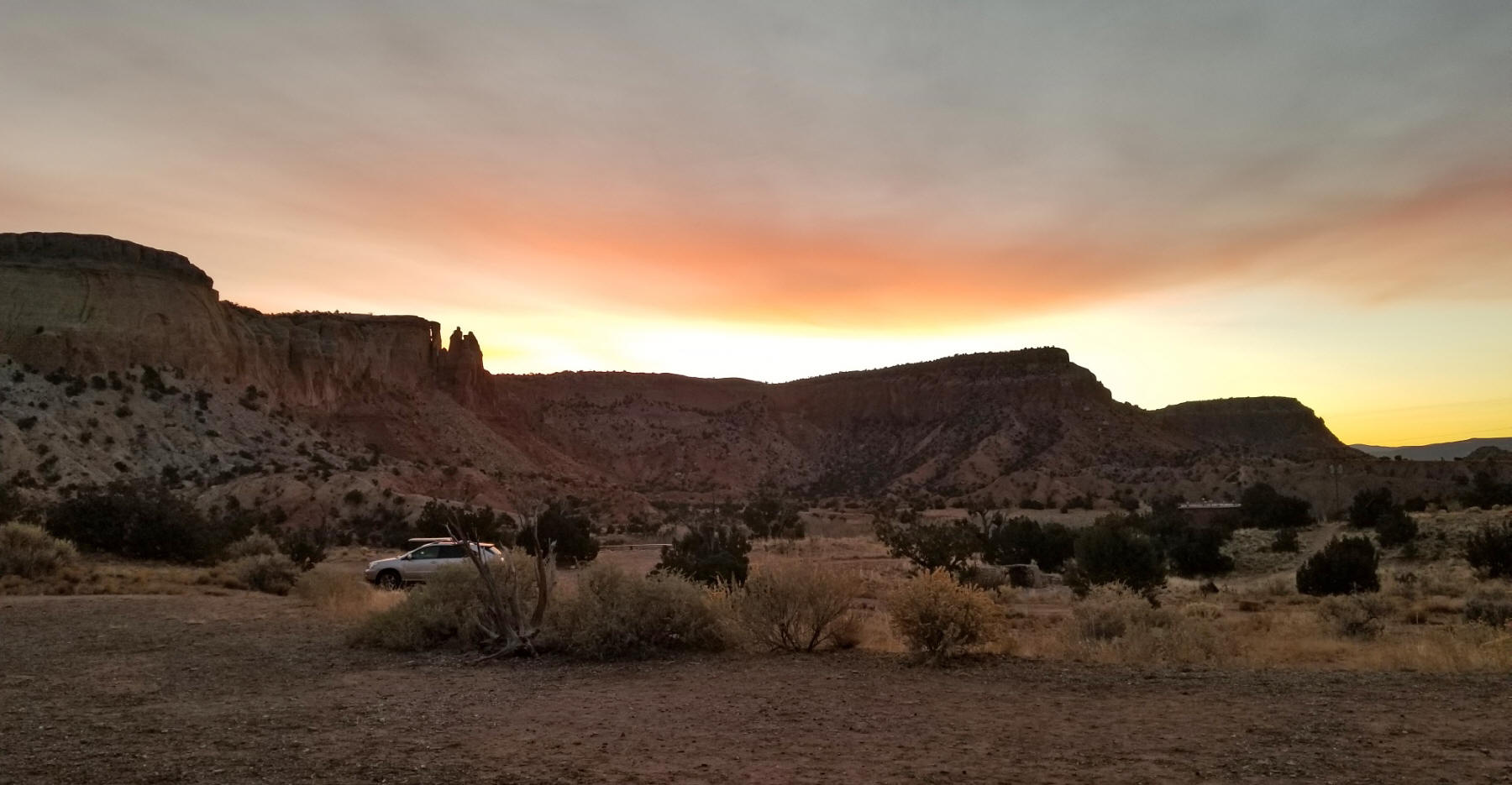Featured Articles
Visiting Susan B. Anthony and Frederick Douglass in
Rochester, NY
Story and photos
by Kathleen
Walls
Published 10-6-2024
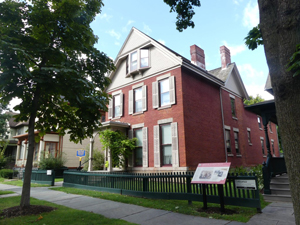 Rochester is rightly proud of two of its most famous
citizens. Susan B. Anthony and Frederick Douglass both
fought for freedom and equal rights. In their time, it
was unusual for a white woman and black man to be good
friends. But since they were both fighting for the same
thing -- equal rights for all people -- it makes sense.
Rochester is rightly proud of two of its most famous
citizens. Susan B. Anthony and Frederick Douglass both
fought for freedom and equal rights. In their time, it
was unusual for a white woman and black man to be good
friends. But since they were both fighting for the same
thing -- equal rights for all people -- it makes sense.
Story by Tom Straka
photos by Pat Straka
Published
10-2-2024
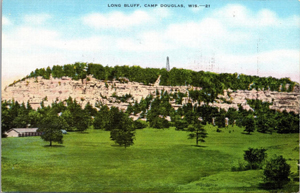 Many wonderful historical and
natural sites are hidden along major highways.
Mill Bluff State Park in
Central Wisconsin is one of them. It is a spectacular
landscape, typical more of the American West, with vistas of
mesas, buttes, and pinnacles.
It isn't really that hidden, as Interstates 90/94 on
the route between Chicago and Minneapolis, pass right
through it near Camp Douglas, just before splitting up. The
interstate only provides a glimpse; the vistas are worthy of
a stop and considerable climb for a breathtaking view.
Many wonderful historical and
natural sites are hidden along major highways.
Mill Bluff State Park in
Central Wisconsin is one of them. It is a spectacular
landscape, typical more of the American West, with vistas of
mesas, buttes, and pinnacles.
It isn't really that hidden, as Interstates 90/94 on
the route between Chicago and Minneapolis, pass right
through it near Camp Douglas, just before splitting up. The
interstate only provides a glimpse; the vistas are worthy of
a stop and considerable climb for a breathtaking view.
Story and photos
by Tom Straka
Published 8-19-2024
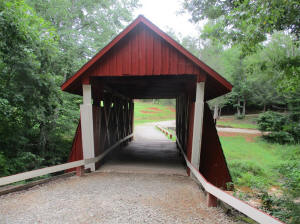 I have recently highlighted
some attractions along South Carolina's Cherokee Foothills
Scenic Highway (S.C. Highway 11) in this ezine, a way to
avoid most of Interstate 85 while travelling between
Charlotte and Atlanta. There are two attractions on that
route, which do not have any formal organization sponsoring
them, but have the appeal of being located in beautiful
natural settings, with enough history to be included in the
National Register of Historic Places. They are South
Carolina's oldest bridge and its last remaining covered
bridge. By coincidence, they are only seven miles apart as
the crow flies, or 14 miles by road. Both are very close to
the Foothills Highway, presenting a great opportunity to
visit a couple of really charming bridges. Both are located
east of the intersection of the Foothills Highway and U.S.
Highway 25.
I have recently highlighted
some attractions along South Carolina's Cherokee Foothills
Scenic Highway (S.C. Highway 11) in this ezine, a way to
avoid most of Interstate 85 while travelling between
Charlotte and Atlanta. There are two attractions on that
route, which do not have any formal organization sponsoring
them, but have the appeal of being located in beautiful
natural settings, with enough history to be included in the
National Register of Historic Places. They are South
Carolina's oldest bridge and its last remaining covered
bridge. By coincidence, they are only seven miles apart as
the crow flies, or 14 miles by road. Both are very close to
the Foothills Highway, presenting a great opportunity to
visit a couple of really charming bridges. Both are located
east of the intersection of the Foothills Highway and U.S.
Highway 25.
Kathleen Walls
published 7-31-2024
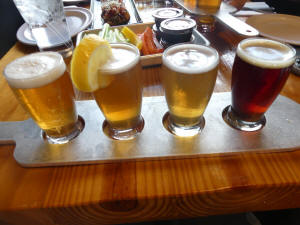 Distilleries, wineries and breweries in
the Carolinas are great spots to visit on your next road
trip. They have some very unique ones. Here are a few
of my favorites.
Distilleries, wineries and breweries in
the Carolinas are great spots to visit on your next road
trip. They have some very unique ones. Here are a few
of my favorites.
Story and photos
by Tom Straka
Published 7-27-2024
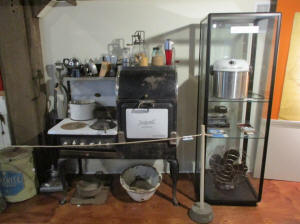 A
few South Carolina counties have a little bit of the Blue
Ridge Mountains, jutting against North Carolina. The extreme
northeastern one is Oconee County and that jut gives it an
excellent flavor of Appalachian culture. It is an interesting
county, bisected by the Cherokee Foothills Scenic Highway (SC
Highway 11), with the area north of the highway being
distinctively flavored. The Foothills Highway is a panoramic
way to get off Interstate 85 with light traffic and connecting
back to the interstate at both ends of the state. There are
numerous short excursions to sample Oconee County; a couple
have been noted in this story:
Oconee Station, part of the state's frontier history,
and a
road trip to an unfinished railroad tunnel near the
river used to film the Movie Deliverance. The
Oconee
History Museum offers additional insights into the
area's fascinating history. The museum has two locations,
the main museum and a general store museum nearby, plus
additional museums almost adjacent centered on Native
American and military history, together providing the
perfect places for a side trip off of the Foothills Highway.
A
few South Carolina counties have a little bit of the Blue
Ridge Mountains, jutting against North Carolina. The extreme
northeastern one is Oconee County and that jut gives it an
excellent flavor of Appalachian culture. It is an interesting
county, bisected by the Cherokee Foothills Scenic Highway (SC
Highway 11), with the area north of the highway being
distinctively flavored. The Foothills Highway is a panoramic
way to get off Interstate 85 with light traffic and connecting
back to the interstate at both ends of the state. There are
numerous short excursions to sample Oconee County; a couple
have been noted in this story:
Oconee Station, part of the state's frontier history,
and a
road trip to an unfinished railroad tunnel near the
river used to film the Movie Deliverance. The
Oconee
History Museum offers additional insights into the
area's fascinating history. The museum has two locations,
the main museum and a general store museum nearby, plus
additional museums almost adjacent centered on Native
American and military history, together providing the
perfect places for a side trip off of the Foothills Highway.
Kathleen Walls
7-26-2024
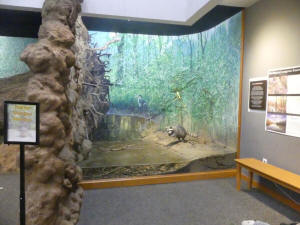 South Carolina has an under-appreciated
treasure in its heartlands. Congaree National Park in the
Midlands, just about 18 miles from Columbia, is South
Carolina's only national park. It's the largest preserved
section of old growth bottomland hardwood forest in the
southeastern United States providing a unique ecosystem that
supports native wildlife, including bobcats, deer,
armadillos, turkeys, alligators, snakes, feral hogs, and
over 2000 bird species, one of the largest number in the
country, and ancient trees. There is a small museum in the
visitor's center telling the history and wildlife found
there. The park offers over 25 miles of hiking trails and
2.5 miles of boardwalks. There's a canoe trail where you can
bring your own kayak or canoe and paddle or rent one. It
also allows primitive camping. Sadly, it's the
third-least-visited park east of the Mississippi.
South Carolina has an under-appreciated
treasure in its heartlands. Congaree National Park in the
Midlands, just about 18 miles from Columbia, is South
Carolina's only national park. It's the largest preserved
section of old growth bottomland hardwood forest in the
southeastern United States providing a unique ecosystem that
supports native wildlife, including bobcats, deer,
armadillos, turkeys, alligators, snakes, feral hogs, and
over 2000 bird species, one of the largest number in the
country, and ancient trees. There is a small museum in the
visitor's center telling the history and wildlife found
there. The park offers over 25 miles of hiking trails and
2.5 miles of boardwalks. There's a canoe trail where you can
bring your own kayak or canoe and paddle or rent one. It
also allows primitive camping. Sadly, it's the
third-least-visited park east of the Mississippi.
Midwestern Lodging of a
Different Era
Kathleen Walls
7-5-2024
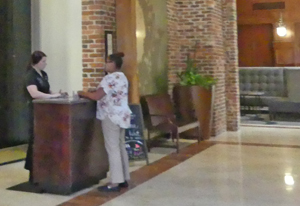 There are many hotels that reflect
a certain period of American life in the mid-west. Here are
four of my favorites. I'll bet you would love them too.
There are many hotels that reflect
a certain period of American life in the mid-west. Here are
four of my favorites. I'll bet you would love them too.
Kathleen Walls
Published 7-1-2024
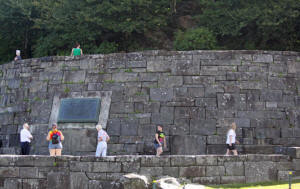 In
1933, President Franklin Roosevelt faced with the worst
depression in American history needed to kick start the
economy. Part of his New Deal was an organization designed to
employ young men. He called it the Civilian Conservation Corps
(CCC) and it did much more than give millions of young men
jobs on environmental projects. As travelers, we owe a lot to
an organization that has been somewhat forgotten over the
years. The CCC earned the nickname,
'Roosevelt's Tree Army.'
These parks continue to provide a natural attraction and
much of the buildings these young men built are still in use
at parks across the country today.
In
1933, President Franklin Roosevelt faced with the worst
depression in American history needed to kick start the
economy. Part of his New Deal was an organization designed to
employ young men. He called it the Civilian Conservation Corps
(CCC) and it did much more than give millions of young men
jobs on environmental projects. As travelers, we owe a lot to
an organization that has been somewhat forgotten over the
years. The CCC earned the nickname,
'Roosevelt's Tree Army.'
These parks continue to provide a natural attraction and
much of the buildings these young men built are still in use
at parks across the country today.
Kathleen Walls
6-18-2024
 I remember back in school during the
Cold War years we were told, “Get under your desk when a
nuclear air raid sounds.” Yeah, that really would have
protected us from a nuclear bomb! There were science fiction
books and rumors of underground nuclear missile silos built
to retaliate if Russia fired a missile at the US. Later
years proved the rumors were true. Missile silos were built
mostly in western states like Kansas. When the Atlas
missiles became obsolete, the government decommissioned the
missile bases, removed the obsolete missile, and sold the
property. One in
Wilson, Kansas was bought by Matthew
Fulkerson.
I remember back in school during the
Cold War years we were told, “Get under your desk when a
nuclear air raid sounds.” Yeah, that really would have
protected us from a nuclear bomb! There were science fiction
books and rumors of underground nuclear missile silos built
to retaliate if Russia fired a missile at the US. Later
years proved the rumors were true. Missile silos were built
mostly in western states like Kansas. When the Atlas
missiles became obsolete, the government decommissioned the
missile bases, removed the obsolete missile, and sold the
property. One in
Wilson, Kansas was bought by Matthew
Fulkerson.
Kathleen Walls
6-4-2024
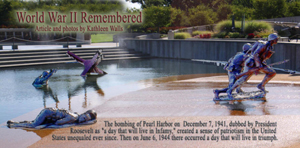 It was on June 6, 1944, on the beaches of
Normandy that the event occurred that foreshadowed the end of WW ll
and of Hitler's reign of terror. Operation
Overlord, the Allies code name for the invasion of France. It
began on the storm torn beaches of Normandy and ended at the
Arch de Triumph with the liberation of Paris. Over my years
travel writing, I've visited many places commemorating the day
know to the world as D-Day. It is something that needs to be
taught in every school and never forgotten.
It was on June 6, 1944, on the beaches of
Normandy that the event occurred that foreshadowed the end of WW ll
and of Hitler's reign of terror. Operation
Overlord, the Allies code name for the invasion of France. It
began on the storm torn beaches of Normandy and ended at the
Arch de Triumph with the liberation of Paris. Over my years
travel writing, I've visited many places commemorating the day
know to the world as D-Day. It is something that needs to be
taught in every school and never forgotten.
Kathleen Walls
6-1-2024
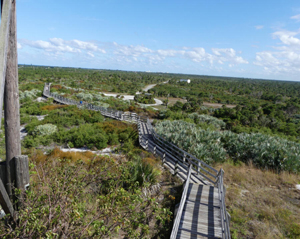 Jonathan
Dickinson State Park on the Loxahatchee River is the largest
state park in Southeast Florida. It's the perfect place to
visit any time of the year. It's in Martin County, Florida,
which offers you wonderful places to explore while camping at
Jonathan Dickinson Park. One of my visits here was on a
comped press trip, but my opinions are my own.
Jonathan
Dickinson State Park on the Loxahatchee River is the largest
state park in Southeast Florida. It's the perfect place to
visit any time of the year. It's in Martin County, Florida,
which offers you wonderful places to explore while camping at
Jonathan Dickinson Park. One of my visits here was on a
comped press trip, but my opinions are my own.
Kathleen Walls
Updated 5-26-2024
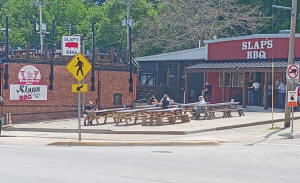 It's been awhile since I first visited
Kansas City but my latest
visit shows it still offers a visitor a hot time in a cool city, Kansas City has it all: hot jazz, spicy barbecue and
tons of sparkling fountains. It's a blend of
Kansas and
Missouri's best
and a city (make that cities) everyone will enjoy.
It's been awhile since I first visited
Kansas City but my latest
visit shows it still offers a visitor a hot time in a cool city, Kansas City has it all: hot jazz, spicy barbecue and
tons of sparkling fountains. It's a blend of
Kansas and
Missouri's best
and a city (make that cities) everyone will enjoy.
Kathleen Walls
Published 5-13-2024
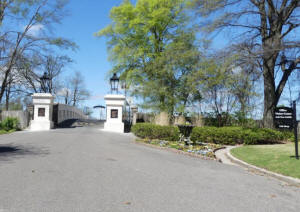 Often a historic cemetery reflects that
city's history. That is the case with beautiful Elmwood
Cemetery in
Memphis. Elmwood was founded in 1852. Elmwood's
executive director Kim Beaden and Amanda Zorn,
Historian/Visitor Services & Volunteer Coordinator, showed me
around the cemetery. It has the feel of a garden with beautiful
southern magnolia, poplar tulip, and giant water oak trees.
Elmwood is divided into sections including the Masonic Section,
the Confederate Rest section, the Yellow Fever Section, African
American Section, and others. Many of the tombstone sculptures
resemble a museum.
Often a historic cemetery reflects that
city's history. That is the case with beautiful Elmwood
Cemetery in
Memphis. Elmwood was founded in 1852. Elmwood's
executive director Kim Beaden and Amanda Zorn,
Historian/Visitor Services & Volunteer Coordinator, showed me
around the cemetery. It has the feel of a garden with beautiful
southern magnolia, poplar tulip, and giant water oak trees.
Elmwood is divided into sections including the Masonic Section,
the Confederate Rest section, the Yellow Fever Section, African
American Section, and others. Many of the tombstone sculptures
resemble a museum.
Kathleen Walls
Published 5-3-2024
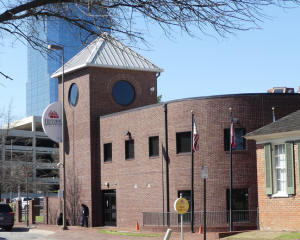 You may think of
Little Rock as just the
capital of Arkansas, but did you know it has many unusual
attractions worth a trip. Little Rock has attractions that are
the biggest, oldest, first, or only one of a kind ranging from
history to nature and culture. Here are a few things you will
find only in Little Rock.
You may think of
Little Rock as just the
capital of Arkansas, but did you know it has many unusual
attractions worth a trip. Little Rock has attractions that are
the biggest, oldest, first, or only one of a kind ranging from
history to nature and culture. Here are a few things you will
find only in Little Rock.
Story and photos
by Kathleen Walls
Published 4-30-2024
.JPG) This
year I was fortunate enough to be invited to the Southeast
Tourism Society Showcase in Little Rock. As those of you who
follow my trips know, that usually includes a post trip. This
year it was a delightful deep dive into newer territory for
me. We visited Murfreesboro and
Hot Springs. It was an
interesting trip as I learned so much I had not known before,
ranging from pre-historic colonies, digging for diamonds, to
conflicts with the law. One of the most fun places we visited
was the Gangster Museum in Hot Springs. We visited Crater of
Diamonds State Park, where we dug for diamonds. Had we found
any, we could have kept them. Perfectly legal. Unfortunately,
I didn't find any diamonds but got a deeper insight into
legal situations in a short run-in with a Barney Fife
Wannabe.
This
year I was fortunate enough to be invited to the Southeast
Tourism Society Showcase in Little Rock. As those of you who
follow my trips know, that usually includes a post trip. This
year it was a delightful deep dive into newer territory for
me. We visited Murfreesboro and
Hot Springs. It was an
interesting trip as I learned so much I had not known before,
ranging from pre-historic colonies, digging for diamonds, to
conflicts with the law. One of the most fun places we visited
was the Gangster Museum in Hot Springs. We visited Crater of
Diamonds State Park, where we dug for diamonds. Had we found
any, we could have kept them. Perfectly legal. Unfortunately,
I didn't find any diamonds but got a deeper insight into
legal situations in a short run-in with a Barney Fife
Wannabe.
Story and photos
by Kathleen Walls
Published 3-6-2024
 Great
Smoky Mountain National Park is a place you could spend days
or even weeks exploring. It is America's most visited
national park.
Cades Cove is one of the most popular places in the park, but
there is another lesser-known section where history still
lives.
Pink Jeep Tours takes you there.
Great
Smoky Mountain National Park is a place you could spend days
or even weeks exploring. It is America's most visited
national park.
Cades Cove is one of the most popular places in the park, but
there is another lesser-known section where history still
lives.
Pink Jeep Tours takes you there.
Story and photos
by Kathleen Walls
Published 1-21-2024
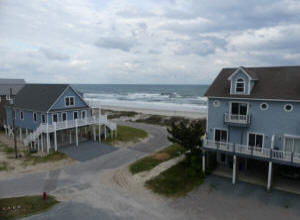 For the first half of the 20th
century Onslow County was a quiet fishing village. It also
produced naval stores, lumber, and tobacco crops as its main
source of income. Then in 1941, Onslow County and the entire
world changed. WWII brought Marine Barracks Camp Lejeune to
Jacksonville, Onslow's main city. Today, tourism plays a major
role in the area. It has varied attractions and world-class
dining you won't find anywhere else.
For the first half of the 20th
century Onslow County was a quiet fishing village. It also
produced naval stores, lumber, and tobacco crops as its main
source of income. Then in 1941, Onslow County and the entire
world changed. WWII brought Marine Barracks Camp Lejeune to
Jacksonville, Onslow's main city. Today, tourism plays a major
role in the area. It has varied attractions and world-class
dining you won't find anywhere else.
Story and photos
by Tom Straka
Published 12-26-2023
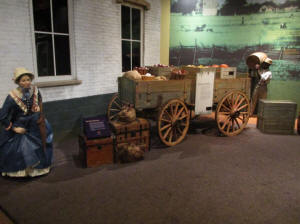 Some cities are full of museums. For a
history buff like me, it is fortunate cities often put a
priority on preserving local history, making history museums
fairly common.
Greenville, South Carolina has an unusual
assortment of
museums,
including two military history museums, a creative arts center,
museum of art, children's museum, music museum, and even a
Shoeless Joe Jackson museum and baseball library. One of the
art museum
collections in the city is said to be the second largest
collection of religious art in the world (second to the
Vatican). Most of these museums are walking distance from one
another, so Greenville offers a great opportunity for
museum-lovers.
Some cities are full of museums. For a
history buff like me, it is fortunate cities often put a
priority on preserving local history, making history museums
fairly common.
Greenville, South Carolina has an unusual
assortment of
museums,
including two military history museums, a creative arts center,
museum of art, children's museum, music museum, and even a
Shoeless Joe Jackson museum and baseball library. One of the
art museum
collections in the city is said to be the second largest
collection of religious art in the world (second to the
Vatican). Most of these museums are walking distance from one
another, so Greenville offers a great opportunity for
museum-lovers.
Story and photos
by Kathleen Walls
Published 12-16-2023
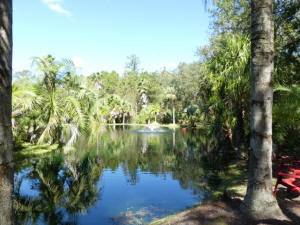 As a long-time Florida resident, I am
familiar with palm trees but until I visited St. Johns
Botanical Garden and Nature Preserve (SJBGNP), I had no idea
there were so many variants. Dr. John Rossi, founder and
resident biologist led our small group on a tour of the garden.
The garden is
St. Johns County's newest attraction. It focuses
on an important, but often neglected side of the county, the
natural side.
As a long-time Florida resident, I am
familiar with palm trees but until I visited St. Johns
Botanical Garden and Nature Preserve (SJBGNP), I had no idea
there were so many variants. Dr. John Rossi, founder and
resident biologist led our small group on a tour of the garden.
The garden is
St. Johns County's newest attraction. It focuses
on an important, but often neglected side of the county, the
natural side.
Story and photos
by Kathleen Walls
Published 12-10-2023
 Lafayette
Parish in Louisiana is alive with music. It's a part of their
culture. In the
1760s, thousands of Arcadians driven out of Canada because of
their religion were welcomed in Catholic Spanish owned
Louisiana. They brought their music with them. However, in
the new environment, it modified to create a totally
different music from French Canadian. Ranger Jodie at the
Acardian Cultural Center in Lafayette explained, 'The main
instrument in Cajun music is the German accordion. And then
we have the fiddle which is French we also have a guitar
which is a Spanish influence and we have the triangle, rub
board and spoons which are African instruments.'
Lafayette
Parish in Louisiana is alive with music. It's a part of their
culture. In the
1760s, thousands of Arcadians driven out of Canada because of
their religion were welcomed in Catholic Spanish owned
Louisiana. They brought their music with them. However, in
the new environment, it modified to create a totally
different music from French Canadian. Ranger Jodie at the
Acardian Cultural Center in Lafayette explained, 'The main
instrument in Cajun music is the German accordion. And then
we have the fiddle which is French we also have a guitar
which is a Spanish influence and we have the triangle, rub
board and spoons which are African instruments.'
Srory and photos
by Kathleen Walls
Published 10-26-2023
.JPG) The
Jacksonville Zoo And Gardens is one of the top zoos in the
United States. They are doing it big for Halloween with their
36th annual
Spooktacular. A few ghosts and ghouls fit right in with the
wildlife. You enter beneath the watchful eye of some giant
skeletons. Then pass under a Spooktacular archway.
The
Jacksonville Zoo And Gardens is one of the top zoos in the
United States. They are doing it big for Halloween with their
36th annual
Spooktacular. A few ghosts and ghouls fit right in with the
wildlife. You enter beneath the watchful eye of some giant
skeletons. Then pass under a Spooktacular archway.
Bristol: Birthplace of Country Music
Story and photos by
Kathleen Walls
Published 9-14-2023
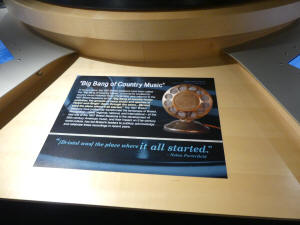 Birthplace of Country Music in
Bristol,
Virginia/Tennessee has a fantastic history behind it. The
Museum tells how country music was recognized as a genre at the
famous 1927 Bristol Sessions. It's an amazing story.
Birthplace of Country Music in
Bristol,
Virginia/Tennessee has a fantastic history behind it. The
Museum tells how country music was recognized as a genre at the
famous 1927 Bristol Sessions. It's an amazing story.
Story by Tom Straka
Photographs by Pat Straka
Published 9-4-2023
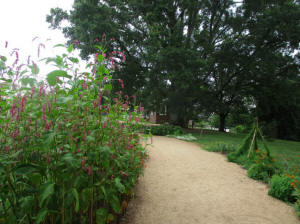 About a year ago we spent the better part of a day at
Monticello, the home of Thomas Jefferson. The details are in an
earlier article in this digital magazine. While Monticello
is recognized as one of America's most famous homes, the
grounds surrounding Monticello are almost as interesting as the
house. They were attractive enough to bring us back for a
second visit, centered on the restored vegetable and flower
gardens, orchards, Jefferson's favorite trees, and a bunch of
fascinating outbuildings. They were well worth a second better
part of a day. Tours at Monticello have various options, mainly
the house tour and the
gardens and grounds tour.
About a year ago we spent the better part of a day at
Monticello, the home of Thomas Jefferson. The details are in an
earlier article in this digital magazine. While Monticello
is recognized as one of America's most famous homes, the
grounds surrounding Monticello are almost as interesting as the
house. They were attractive enough to bring us back for a
second visit, centered on the restored vegetable and flower
gardens, orchards, Jefferson's favorite trees, and a bunch of
fascinating outbuildings. They were well worth a second better
part of a day. Tours at Monticello have various options, mainly
the house tour and the
gardens and grounds tour.
Story and photos
by Kathleen Walls Published 7-27-2023
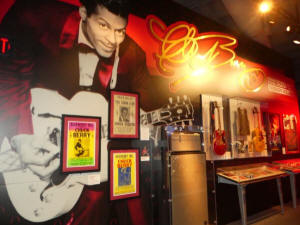 I
just visited
Cleveland's Rock and Roll Hall of Fame. It's an
amazing time travel trip into American music. Sure, it's
about rock and roll, but remember rock and roll evolved from
blues and country with many other genres adding a touch or
two. What I love about the museum is that it takes that into
consideration and showcases those early influences. Over the
years, they have inducted many influencers, including Sister
Rosetta Tharpe,
Ma
Rainey,
Robert Johnson, Hank Williams, Bob Willis, and countless
other musician whose music led to rock and roll.
I
just visited
Cleveland's Rock and Roll Hall of Fame. It's an
amazing time travel trip into American music. Sure, it's
about rock and roll, but remember rock and roll evolved from
blues and country with many other genres adding a touch or
two. What I love about the museum is that it takes that into
consideration and showcases those early influences. Over the
years, they have inducted many influencers, including Sister
Rosetta Tharpe,
Ma
Rainey,
Robert Johnson, Hank Williams, Bob Willis, and countless
other musician whose music led to rock and roll.
Story and photos
by Tom Straka
Published 7-17-2023
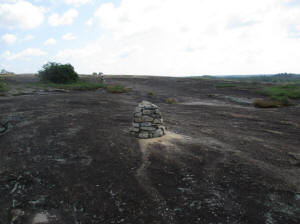 Newsweek magazine recently
published an
article
with a catchy title: “The Weirdest, Most Extraterrestrial Spots
You Can Visit, Here on Earth,” promising “some of Earth's most
bizarrely surreal natural wonders.” There were eleven
locations, ranging from a national forest park in China with
bizarre rock formations, a desert in Canada's Yukon, Easter
Island, the world's largest salt flat in Bolivia, the Skeleton
Coast of Namibia, to Glowworm Caves in New Zealand. One
location caught my eye, as it is only a few hours away. The
Arabia Mountain Natural Area, just east of Atlanta, was
described as “as close to the experience of walking on the
moon's surface as we have on Earth.” As you begin the hike up
Arabia Mountain, shown in the lead photograph, you are on solid
rock, and the scant forest soon gives way to the “lunar
surface.” You'll be on a monadnock.
Newsweek magazine recently
published an
article
with a catchy title: “The Weirdest, Most Extraterrestrial Spots
You Can Visit, Here on Earth,” promising “some of Earth's most
bizarrely surreal natural wonders.” There were eleven
locations, ranging from a national forest park in China with
bizarre rock formations, a desert in Canada's Yukon, Easter
Island, the world's largest salt flat in Bolivia, the Skeleton
Coast of Namibia, to Glowworm Caves in New Zealand. One
location caught my eye, as it is only a few hours away. The
Arabia Mountain Natural Area, just east of Atlanta, was
described as “as close to the experience of walking on the
moon's surface as we have on Earth.” As you begin the hike up
Arabia Mountain, shown in the lead photograph, you are on solid
rock, and the scant forest soon gives way to the “lunar
surface.” You'll be on a monadnock.
Kathleen Walls
Published 7-2-2023
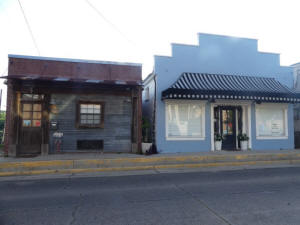 I
had a wonderful experience when I visited New Iberia. There
was so much more than I expected.
New Iberia
is a quiet
little town on the banks of Bayou Teche with a big history.
Founded in 1779, by Spaniards New Iberia is the only
Louisiana city retaining a Spanish name. Later, the Acadians,
settled there after being driven out of Nova Scotia by the
British.
I
had a wonderful experience when I visited New Iberia. There
was so much more than I expected.
New Iberia
is a quiet
little town on the banks of Bayou Teche with a big history.
Founded in 1779, by Spaniards New Iberia is the only
Louisiana city retaining a Spanish name. Later, the Acadians,
settled there after being driven out of Nova Scotia by the
British.
For earlier stories click
here.
Public Disclosure
Please Read
FTC has a law
requiring web sites to let their readers know if any of the
stories are 'sponsored' or compensated. We also are to
let readers know if any of our links are ads. Most are not.
They are just a way to direct you to more information
about the article where the link is placed. We have several ads
on our pages. They are clearly marked as ads. I think
readers are smart enough to know an ad when they see one but to
obey the letter of the law, I am putting this statement here to
make sure everyone understands. American Roads and Global
Highways may contain affiliate links or ads. Further, as their
bios show, most of the feature writers are professional travel
writers. As such we are frequently invited on press trips, also
called fam trips. On these trips most of our lodging, dining,
admissions fees and often plane fare are covered by the city or
firm hosting the trip. It is an opportunity to visit places we
might not otherwise be able to visit. However, no one tells us
what to write about those places. All opinions are 100% those
of the author of that feature column.

